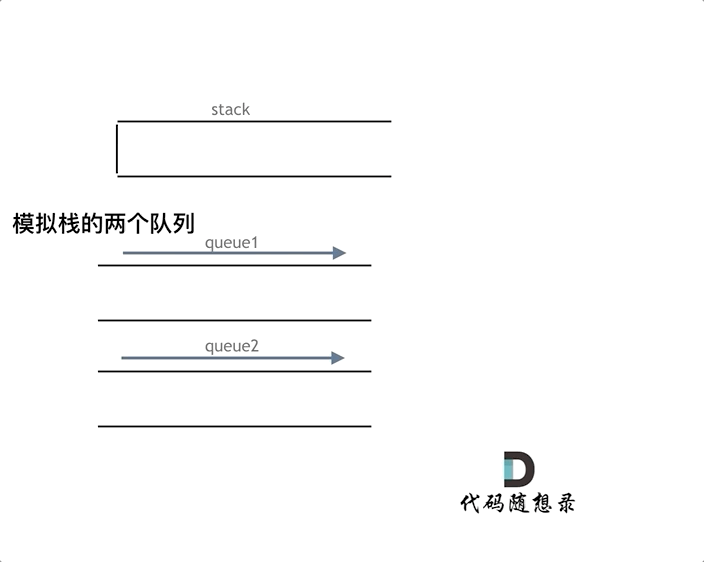今日任务
- 栈与队列的理论基础 (介绍:代码随想录)
- 232 用栈实现队列(题目: . - 力扣(LeetCode))
- 225 用队列实现栈 (题目: . - 力扣(LeetCode) )
栈与队列的理论基础
栈 : 先进后出 队列: 后进先出

老师给的讲解:代码随想录 这个可能适合于 c++的同学理解,我的 go 看这里是有点不明所以..
232 用栈实现队列
请你仅使用两个栈实现先入先出队列。队列应当支持一般队列支持的所有操作(push、pop、peek、empty):
说明:
- 你 只能 使用标准的栈操作 —— 也就是只有
push to top,peek/pop from top,size, 和is empty操作是合法的。 - 你所使用的语言也许不支持栈。你可以使用 list 或者 deque(双端队列)来模拟一个栈,只要是标准的栈操作即可。
想法:
其实我完全理解栈与队列的特性, 先进后出、先进先出嘛, 但是一开始明白这题让干嘛的,在想这是否跟语言有关啊? 下一步直接看题解Go代码,
问题:
看了题解才明白,其实我们就是可以利用各种语言提供的数据类型, 去模拟实现栈的一个效果,栈就是要具有 push 、pop、top、empty 这几个操作. 然后再用栈去实现 队列的操作:push、pop、peek、empty.
那么理解了题意后,才是该思考的问题了,如何用拥有栈特性的数据结构去实现拥有队列属性的数据结构呢??🤔🤔
解决思路:
使用栈来模式队列的行为,如果仅仅用一个栈,是一定不行的,所以需要两个栈一个输入栈,一个输出栈,这里要注意输入栈和输出栈的关系。
就是我们将数据 push 到栈里了,这时该如何将第一个 push 到栈的数据通过 pop给先取出来呢? 我们可以借助另一个栈2,将我们另一个栈的数据 全取出来,再 push 到栈 2 里了,这时的栈 2 的元素出栈的顺序就和我们的队列相同了.

图片和题解参考:代码随想录
看代码(Go):
// 先用切片模拟栈,再用两个栈的特性去模拟一个队列的特性
// 1、通过切片实现一个栈的各种操作
type MyStack []int
func (s *MyStack) Push(v int){
*s = append(*s,v)
}
func (s *MyStack) Pop() int {
val := (*s)[len(*s)-1]
*s = (*s)[:len(*s)-1]
return val
}
func (s *MyStack) Peek() int {
val := (*s)[len(*s)-1]
return val
}
func (s *MyStack) Size() int {
return len(*s)
}
func (s *MyStack) Empty() bool{
return s.Size() == 0
}
// 2、下面开始用两个栈实现队列
type MyQueue struct {
inStack *MyStack
outStack *MyStack
}
func Constructor() MyQueue {
return MyQueue {
inStack: &MyStack{},
outStack: &MyStack{},
}
}
func (this *MyQueue) Push(x int) {
this.inStack.Push(x)
}
// 在取之前,要先把入栈里的元素全都取出放到出栈里(如果出栈里仍有数据的话,肯定还是可以直接出的)
func (this *MyQueue) Pop() int {
this.moveStack()
return this.outStack.Pop()
}
func (this *MyQueue) Peek() int {
this.moveStack()
return this.outStack.Peek()
}
func (this *MyQueue) Empty() bool {
return this.inStack.Empty() && this.outStack.Empty()
}
func (this *MyQueue) moveStack() {
// 如果出栈为空的时候,再将入栈里的数据全都移动到出栈里,这样保证所有数据一直按照先进先出的顺序来的
if this.outStack.Empty() {
for !this.inStack.Empty() {
this.outStack.Push(this.inStack.Pop())
}
}
}
225 用队列实现栈
请你仅使用两个队列实现一个后入先出(LIFO)的栈,并支持普通栈的全部四种操作(push、top、pop 和 empty)。
注意:
- 你只能使用队列的标准操作 —— 也就是
push to back、peek/pop from front、size和is empty这些操作。 - 你所使用的语言也许不支持队列。 你可以使用 list (列表)或者 deque(双端队列)来模拟一个队列 , 只要是标准的队列操作即可。
想法:
做了上一题后,我们就明白该如何去用语言已有的数据结构去模拟出栈的操作,我直接用切片就能实现栈的操作哎,但是题目还是让我们用两个队列实现,主要还是想要我们理解其中该如何转换.
问题:
两个队列该如何实现呢? 如果我们像上一题,一个输入一个输出队列模拟还真不行, 因为最后出来的还都是先进先出.
解决思路:
1、两个队列 (题目要求)
依然还是要用两个队列来模拟栈,只不过没有输入和输出的关系,而是另一个队列完全用来备份的!如下面动画所示,用两个队列que1和que2实现队列的功能,que2其实完全就是一个备份的作用,把que1最后面的元素以外的元素都备份到que2,然后弹出最后面的元素,再把其他元素从que2导回que1.
2、一个队列 (更优)
一个队列在模拟栈弹出元素的时候只要将队列头部的元素(除了最后一个元素外) 重新添加到队列尾部,此时再去弹出元素就是栈的顺序了。

图片和题解参考:代码随想录
// 使用1个 队列实现栈的效果
type MyStack struct{ // 初始化
queue []int
}
func Constructor() MyStack {
return MyStack{
queue: make([]int,0),
}
}
func (this *MyStack) Push(x int){
// 添加元素
this.queue = append(this.queue,x)
}
func (this *MyStack) Pop() int {
// 取出元素,因为我们当前是模拟在队列里的,遵守了一个先进先出的顺序,那么为了实现栈,我们要实现后进先出的效果
n := len(this.queue)-1 // 判断长度
// 除了最后一个元素,其余的都重新添加到队列里
for n != 0{
val := this.queue[0]
// 截掉第一个元素,即将加入到队尾
this.queue=this.queue[1:]
this.queue=append(this.queue,val)
n--
}
// 弹出元素
val := this.queue[0]
this.queue = this.queue[1:]
return val
}
func (this *MyStack) Top() int {
val := this.Pop()
// 先弹出来,再添加进去,虽然这个过程也挺无语的,就是先来了个 for 循环把最后一个元素取出来了,然后再推进去.
this.Push(val)
return val
}
func (this *MyStack) Empty() bool {
return len(this.queue) == 0
}
// 两个队列实现的
type MyStack struct {
//创建两个队列
queue1 []int
queue2 []int
}
func Constructor() MyStack {
return MyStack{ //初始化
queue1:make([]int,0),
queue2:make([]int,0),
}
}
func (this *MyStack) Push(x int) {
//先将数据存在queue2中
this.queue2 = append(this.queue2,x)
//将queue1中所有元素移到queue2中,再将两个队列进行交换
this.Move()
}
func (this *MyStack) Move(){
if len(this.queue1) == 0{
//交换,queue1置为queue2,queue2置为空
this.queue1,this.queue2 = this.queue2,this.queue1
}else{
//queue1元素从头开始一个一个追加到queue2中
this.queue2 = append(this.queue2,this.queue1[0])
this.queue1 = this.queue1[1:] //去除第一个元素
this.Move() //重复
}
}
func (this *MyStack) Pop() int {
val := this.queue1[0]
this.queue1 = this.queue1[1:] //去除第一个元素
return val
}
func (this *MyStack) Top() int {
return this.queue1[0] //直接返回
}
func (this *MyStack) Empty() bool {
return len(this.queue1) == 0
}我这一开始提交的可以直接通过,但是不是队列实现栈,哈哈...
// 我这下面的栈并不是由队列实现的? 感觉有点奇怪,直接就用了下标索引取值的很 easy
type MyStack struct {
queue []int
}
func Constructor() MyStack {
return MyStack{
queue: make([]int,0),
}
}
func (this *MyStack) Push(x int) {
this.queue = append(this.queue,x)
}
func (this *MyStack) Pop() int {
val := this.queue[len(this.queue) - 1]
this.queue = this.queue[0:len(this.queue)-1]
return val
}
func (this *MyStack) Top() int {
return this.queue[len(this.queue) - 1]
}
func (this *MyStack) Empty() bool {
return len(this.queue) == 0
}